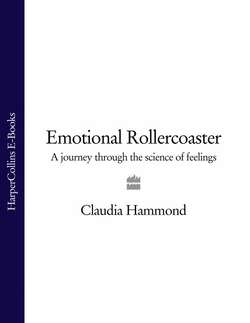Читать книгу Emotional Rollercoaster: A Journey Through the Science of Feelings - Claudia Hammond - Страница 12
the laughing umbrella
ОглавлениеOn the pavement beside a main road in south London two pairs of legs are visible emerging from a huge yellow tent which seems to hover above the people’s heads and only comes down as far as their knees. The whole tent is shaking slightly and from inside there’s the sound of a person laughing uncontrollably. A few people stop and stare, wondering just who these two people are and what could be going on. Then the tent is lifted off and collapsed like an umbrella. Red-faced with laughter the man thanks the woman with blonde, spiky hair for cheering up his day and walks off up the road, still chuckling quietly to himself. Then the woman approaches another passer-by, introduces herself as the artist Nicola Green, and invites her to come under her umbrella. She is collecting laughter and has found that her customised umbrella provides people with the privacy to laugh while she stands with them making a recording. As a portrait artist she had explored unusual ways of capturing the ‘essence of a person’ by painting a family portrait as the backs of people’s heads or a line of feet. Then she noticed how much a person’s laugh reveals and decided that this was the way to access their joy.
Laughing on cue isn’t easy, as I discovered when I stood in her living room under her laughing umbrella. If you’re passing by in the street then the ludicrous nature of the situation might make it easy, but since I’d arranged to meet Nicola and knew exactly what she was doing, when it actually came to it, I found it surprisingly difficult to laugh. Luckily she has ways of helping reluctant laughers. By encouraging you to fake a ridiculous cackle, she makes you laugh genuinely. She even went on the tube in London, where laughing between strangers simply doesn’t happen, chose a carriage and then shouted out, ‘I want to record your laughter. When I blow the whistle I want you all to laugh.’ Twitching glances crossed the carriage between passengers. Should they do it or not? Could you risk being the only person to laugh? Would it be better to ignore her and hope she moves on? In that split second people make a decision about whether to laugh. She found that either a whole carriage would laugh or nobody would. At Victoria station she somehow persuaded the platform attendants to make a tannoy announcement asking everyone to laugh. Eventually she made her laughter collection into a record, encompassing everyone from her dentist to a vicar in Covent Garden.
It struck me that people often thanked her afterwards for the fun they had had. They clearly felt good, suggesting laughter might provide some sort of physical release. Usually laughing does make people feel better, hence the rows of people happy to sit in laughter clinics, chuckling contentedly. Occasionally, however, laughter does not denote happiness.
